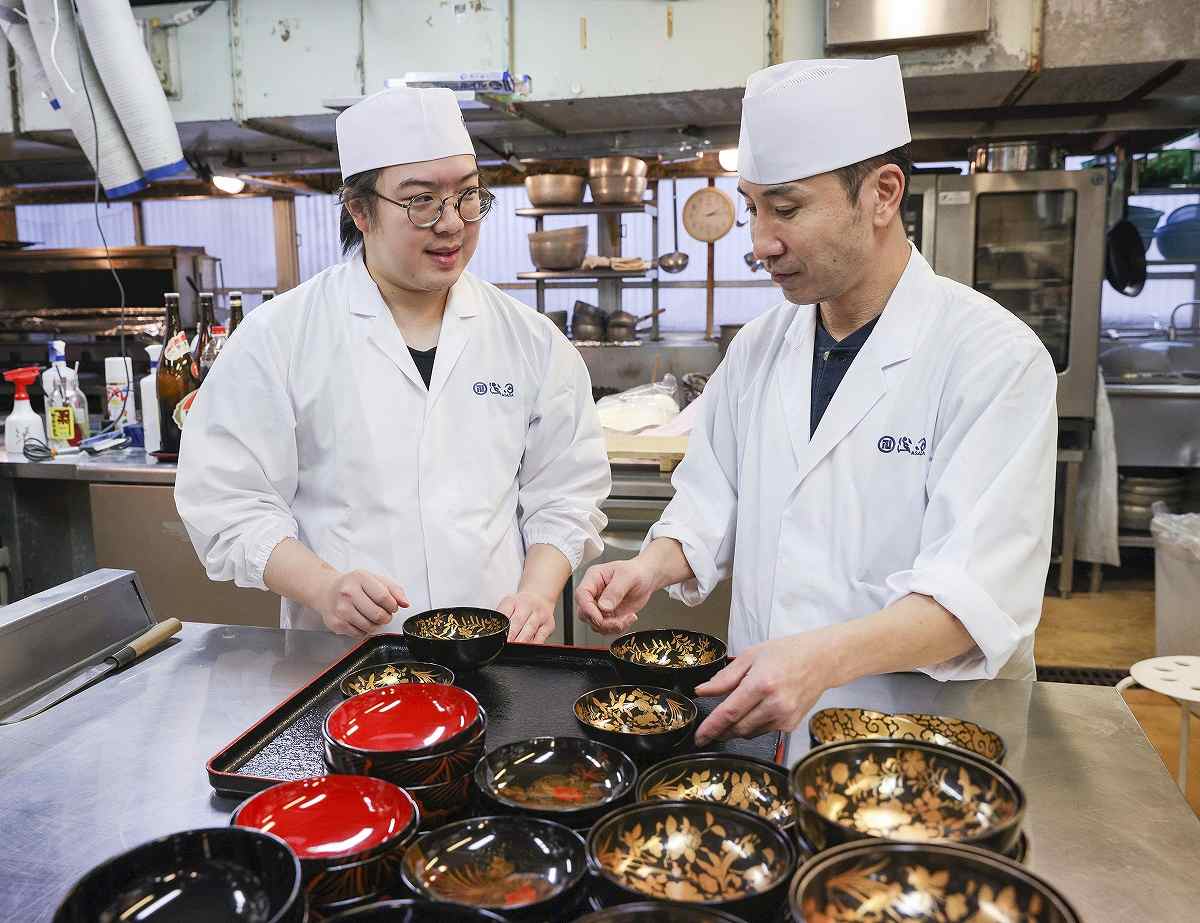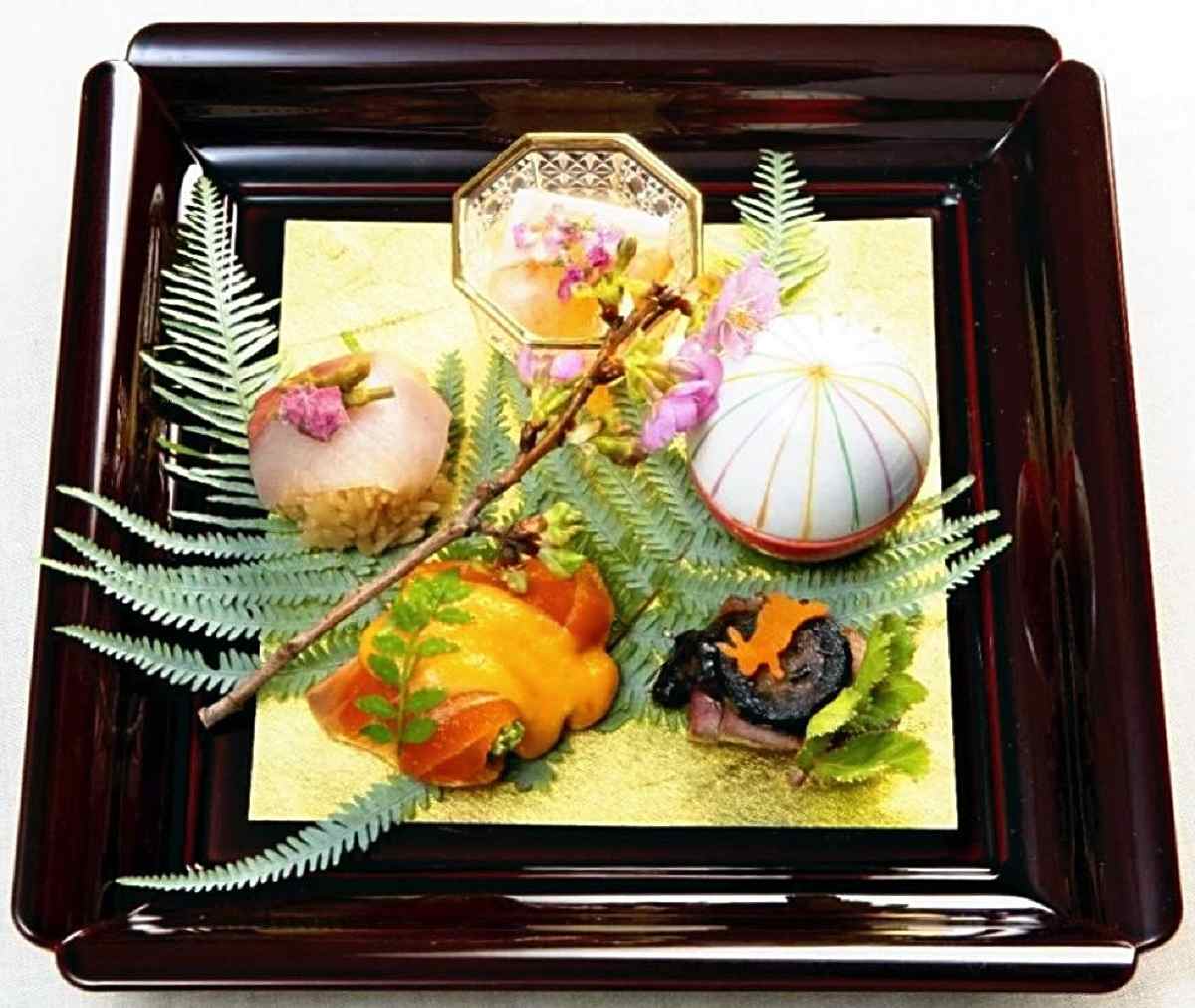Essence of Japanese Food Strikes Chord with Foreign Chefs; Washoku Celebrates 10 Years on UNESCO List

Vincent Pham, left, learns the spirit of hospitality and how to arrange bowls from his senior at Akasaka Asada in Minato Ward, Tokyo.
14:30 JST, January 28, 2024
More than 10 years have passed since washoku — Japanese cuisine — was registered as a UNESCO intangible cultural heritage in December 2013. While washoku has gained popularity overseas, people in Japan have fewer opportunities to make it due to the diversification of food.
The number of Japanese restaurants overseas more than tripled from about 55,000 in 2013 to 187,000 in 2023. Foreign nationals have increasingly come to Japan to obtain authentic culinary knowledge and learn cooking skills and the spirit of hospitality. They have taken advantage of their experience to then pursue their career in their native countries.
Vincent Pham, a 24-year-old Canadian, is currently training at Akasaka Asada, a Kaga-style cuisine restaurant in Tokyo.
One of his seniors once told him, “Make sure you put the lid on the bowl so both the design on the bowl and the lid face the customer when they open the lid and then place it on the right side of the bowl.”
Such instructions have taught him the spirit of hospitality, making him realize that in Japanese cuisine, something as small as how a bowl is placed on the table shows respect for the customer.
Despite his experience working at a Japanese restaurant in Canada for two years, Pham is now learning from scratch, including how to prepare vegetables and serve dishes as well as cleaning the kitchen. His training is set for six months.
As of 2023, there were 2,610 Japanese restaurants in Canada.
Pham said that with public interest in washoku growing, there has been a growing demand for restaurants that serve traditional Japanese cuisine. He also wants to promote other aspects of washoku, such as tableware and arrangement.
“Foreign trainees are eager to learn, so chefs at restaurants are also inspired by them,” said Shota Asada, the owner of Akasaka Asada. “As they spread the knowledge and techniques of Japanese cuisine in their native countries, that leads to an increase in the value of Japanese cuisine.”
The Japanese Cuisine and Food Culture Human Resource Development Committee has conducted a training program for chefs since fiscal 2016, and the Agriculture, Forestry and Fisheries Ministry has subsidized it. A total of 274 people, including online participants during the COVID-19 pandemic, have received training.
In the same fiscal year, the committee also drew up guidelines for a certification system, under which private organizations certify foreign chefs who have reached a certain level of culinary skill.
Foreign nationals working at Japanese restaurants overseas have also improved their skills in washoku.
In February last year, the agriculture ministry held the 10th Washoku World Challenge, in which foreign chefs competed using their skills in cooking Japanese cuisine.
“This is the first time I saw contestants with such impressively high skills,” said head judge Yoshihiro Murata, the owner and chef of the restaurant Kikunoi. “All the contestants were able to make dashi well. They are all great chefs with individuality.”
The final had the contestants creating nimonowan, a simmered dish, along with five appetizers. Jakub Horak, 27, who used to work at a Japanese restaurant in the Czech Republic for 10 years, won first place. Murata described Horak’s nimonowan as “fragrant with yuzu citrus made like mochi puffs.”

Five appetizers prepared by Czech chef Jakub Horak, which were highly praised for their presentation at the 10th Washoku World Challenge.
Horak aspired to become a chef when he was around 17 and started working at a Japanese restaurant run by his parents’ friend. Attracted by washoku’s characteristics of using fresh ingredients and its creativeness, he has honed his culinary skills.
“From now on, I want to become a Japanese food ambassador and introduce people in my home country to a wide variety of great Japanese food that exists beyond sushi, ramen and tempura,” he said.
Last summer, he began offering Japanese cooking classes in the Czech Republic.
“The level of Japanese cuisine [offered overseas] has improved not only in taste but also in aesthetics, such as the arrangement of dishes,” said one of the judges, Naoyuki Yanagihara, who is the head of the Kinsaryu-style of Edo kaiseki traditional cuisine. “An increase in the number of Japanese restaurants overseas and improved levels of culinary skills will encourage the younger generation in Japan, which is said to shy away from Japanese food, to take interest in washoku.”
Overseas specialty restaurants
The number of restaurants featuring Japanese specialty dishes has increased overseas. In addition to okonomiyaki, takoyaki and other flour-based dishes, dishes such as kushiage deep-fried skewers are also popular. Some restaurants offer eel, which is being eaten less in Japan. As for Japanese sweets, taiyaki, a fish-shaped cake, and shaved ice have become more available abroad.
There were 1,260 Japanese restaurants in the U.K. last year. According to Eleanor Yamaguchi, an associate professor at Kyoto Prefectural University, a wide variety of Japanese restaurants have opened in the U.K.
“Not only upscale restaurants but reasonably priced chain shops, exclusive to Britain, have also increased,” she said. “Noodles, such as soba and udon, are also readily available.”
UNESCO registration
Washoku, as recognized by UNESCO, is not referred to in terms of individual dishes but as a traditional food culture. It is characterized by four main features — respect for fresh and diverse ingredients and their distinctive flavors, a healthy diet with excellent nutritional balance, expression of the beauty of nature and the changing seasons, and a close relationship with annual events. The registration has encouraged the Japanese government to step up efforts in protecting washoku.
"Features" POPULAR ARTICLE
-

Sanrio to Open Museum in Yamanashi Pref. Dedicated to Founder, Exhibits Include Hello Kitty, Other Characters
-

Autumn Foliage Surrounds Visitors to Tokyo’s Showa Kinen Park
-

My Daughter No Longer Speaks to Me, But I Want to See Her and My Grandchild
-

Kumamoto: Public Bath Refurbished as Library Where You Can Chat, Take Photos
-

Frozen Vegetables: Demand Rises for Convenient, Tasty Domestic Produce
JN ACCESS RANKING
-

Tokyo Economic Security Forum to Hold Inaugural Meeting Amid Tense Global Environment
-

Keidanren Chairman Yoshinobu Tsutsui Visits Kashiwazaki-Kariwa Nuclear Power Plant; Inspects New Emergency Safety System
-

Imports of Rare Earths from China Facing Delays, May Be Caused by Deterioration of Japan-China Relations
-

University of Tokyo Professor Discusses Japanese Economic Security in Interview Ahead of Forum
-

Japan Pulls out of Vietnam Nuclear Project, Complicating Hanoi’s Power Plans


























